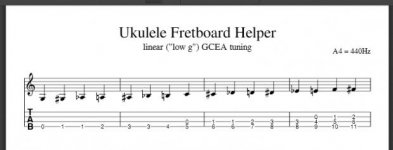There's a lot of fretboard maps out there already, but they usually never link the note names on the fretboard to the notes in musical notation.
Should anyone be interested try one of these fretboard helpers:
This is what it looks like:

pls notify me of any bugs you find - and feel free to ask for other tunings
update 2015-12-12:
- added the rare notes E# and B# (I've hardly ever seen Fb or Cb, so I left these out)
- added low a version
- added version date to all updated files
- added note names to all updated files
update 2016-06-10
- added re-entrant DGBE and FBbDG as requested in post #18
Should anyone be interested try one of these fretboard helpers:
- GCEA re-entrant (aka high-g): tenor, concert, soprano, (sopranino)
- GCEA linear (low-g): tenor, concert
- ADF#B re-entrant: "canadian" or "european" tuning for concert, soprano
- ADF#B linear
- FBbDG re-entrant (one note below standard GCEA)
- DGBE linear: baritone
first line sounds a full octave lower than noted, but this would have been a visual desaster with all the ledger lines - DGBE re-entrant: baritone
- EADG: bass (for alternate version with additional treble clef notation see post #11)
This is what it looks like:

pls notify me of any bugs you find - and feel free to ask for other tunings
update 2015-12-12:
- added the rare notes E# and B# (I've hardly ever seen Fb or Cb, so I left these out)
- added low a version
- added version date to all updated files
- added note names to all updated files
update 2016-06-10
- added re-entrant DGBE and FBbDG as requested in post #18
Last edited:
